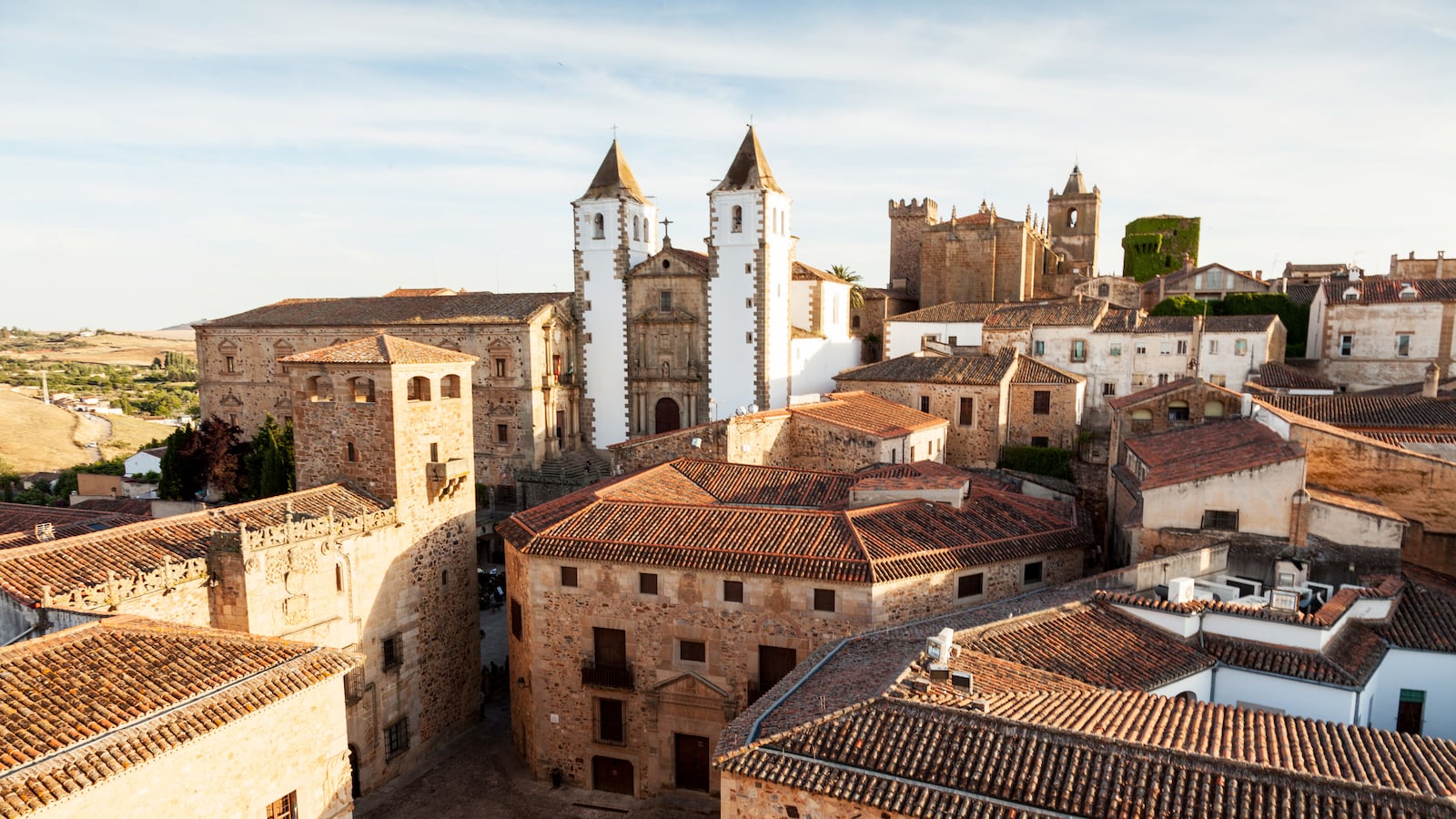This is the latest edition of our twice-a-month series on underrated destinations, It’s Still a Big World.
Ask a well-traveled friend where you should vacation in Spain post pandemic, and you’ll likely get an earful on Barcelona’s dreamy architecture, San Sebastián’s epic pintxo crawls, and Sevilla’s foot-stomping flamenco tablaos. But here’s my hot tip as a six-year Spain transplant who travels to pay the bills: Some of the most exciting news in Spanish travel for 2021 is out of Cáceres, a sleepy medieval city located 180 miles west of Madrid.
I first visited Cáceres in 2017, lured by the promise of porcine delights (acorn-fed ham! spicy patatera sausage!), orange tree-shaded plazas, and one of the best-preserved medieval enclaves in Europe. Approaching the city, I remember gasping at the skyline, all right angles with its low whitewashed houses and 30-some towers, some nearly 1,000 years old. Brick steeples and cupolas shot up between them, lending an aristocratic grandeur to the place. Storks soared overhead.
My first walk through the Ciudad Monumental, or Old Town, revealed sinuous streets lined with mansions, churches, and monasteries built from stone, a foreboding sepia-tinged maze built to last. Perusing the placards on each historical facade as if I were touring a museum, I struggled to find a single building newer than the 16th century. Ornate coats of arms hovering above doorways bore the seals of fairytale surnames that were fun to say aloud: Godoy, Saavedra, Golfín, and Ovando-Mogollón. Everything was preserved as if in amber. The only glaring signs of modernity came in the form of film crew vans and extension cords: The Old Town was being used as a Game of Thrones filming location.
Cáceres peaked early and then sort of calcified. Though the Romans, Jews, and Moors laid the city’s groundwork, erecting towers and installing cisterns (the one beneath the Museum of Cáceres is worth a visit), the city’s heyday was between the late 15th and mid-17th centuries. It was during that period that explorers from the surrounding region—such as Hernán Cortés, Francisco de Orellana, and Francisco Pizarro—brought back shiploads of plundered riches from the so-called New World to fund the city’s opulent constructions.
But then, due the royals’ financial mismanagement, the money dried up. Simultaneously, Cáceres was caught in the crossfire of a protracted war over Portugal, forcing many residents to flee. By the turn of the 20th century, the city was an impoverished, sparsely populated backwater ravaged by centuries of latifundism and neglect. People only began giving Cáceres a second look in 1967, when the Council of Europe declared it the third most significant monumental ensemble on the continent, bested only by Tallinn and Prague. UNESCO named it a World Heritage Site in 1986.
The irony of Cáceres’s dark chapter is that it may have saved the Ciudad Monumental from ruin. Had the city remained prosperous through the centuries, its Old Town would’ve been wrecked to make way for newer buildings.
As the weekend unfolded, I was struck by how well suited Cáceres was to excursions from Madrid. It had it all: stunning churches (I’ll never forget the view from the bell tower of Iglesia de San Francisco Javier), tasty tapas served with gusto, and hotels for every budget. Toledo and Segovia are the most popular field trips from the Spanish capital, but while fascinating in their own right, they’re in-your-face touristy (think magnets and postcards in every corner shop). Cáceres, by comparison, felt like a real vacation—it oozed Spanish history and culture without a tourbus in sight.
After that trip, I talked up Cáceres to anyone who’d listen, but I didn’t have a pressing reason to return until earlier this month, when I got wind of a flurry of news developments: a hotel opening, a museum expansion, revamped official tours, and a new restaurant run by one of Spain’s top chefs. Finally, I thought, Cáceres would get the international buzz it deserves. But then it dawned on me: With leisure travel at a standstill and foreigners largely banned from visiting Spain, Cáceres’s biggest year in over a decade could potentially go unnoticed abroad, another blow to the already-hamstrung tourism industry. Determined to spread the gospel, I bought a train ticket, packed a bunch of masks, and set out to see what there was to look forward to in Cáceres in the After Times.

After ditching my suitcase at the NH Collection Cáceres Palacio de Oquendo, a reliable mid-range hotel housed in a 16th-century stone palace, I zigzagged up into the Old Town. It was pin-drop quiet—no cars, no people, just the squeak of my shoes on the wet cobblestones. My first stop was the Helga Alvear Contemporary Art Museum. When I came here in 2017, I left scratching my head: The low-ceilinged medieval building housed confusingly conceptual art (a pyramid of multicolored balls, garments pinned to a folded rug), and the collection felt clunky and out of place. The German art collector has since thrown money at the problem to the tune of €10 million. Tuñón Architects (of MUSAC fame) are behind the renovation, which added 54,000 square feet to the existing 32,000. From outside the building, I could make out Tuñón’s signature wooden slats peeking above the scaffolding. “It’s going to feel like a completely new museum,” a representative told me over the phone, adding that it would open “sometime” in 2021. “The new space will allow us to finally showcase large-format pieces from the collection that we weren’t previously able to display.”
The Helga Alvear is a five-minute walk from the heart of the old Judería, or Jewish Quarter, a tangle of narrow streets and white single-story houses huddled around the Ermita de San Antonio, originally the main synagogue. “Jewish Cáceres” is one of several new niche-interest tours that the local tourist office will launch in 2021, alongside other itineraries like “Muslim Cáceres,” “Roman Cáceres,” and a route hitting the city’s most scenic viewpoints. (Stop by the tourist office on the Plaza Mayor to inquire about tour schedules.)
But perhaps the most thrilling developments of all are in Cáceres’s hospitality sector. To be fair, there was already plenty to rave about: The city is home to one of Spain’s most exclusive design hotels, Atrio, presided over by Cáceres-born partners (in both business and love) Toño Pérez and José Polo. Atrio’s rooms are dramatically lit and bear original works by Warhol, Tapiès, Ruff, and Saura. Downstairs, Pérez runs a two-Michelin-star kitchen where Extremaduran delicacies like lomo doblao (Ibérico pork loin confited lard) and torta del Casar (a creamy, grassy ewe’s-milk cheese) are woven into tasting menus that will have you crunching on a tapioca “butterfly” filled with salmon mousse one minute and braised partridge draped with black truffles the next.
The duo’s latest passion project, slated to open in the second half of 2021, is an 11-suite hotel catty-corner from Atrio called Casa Palacio Paredes Saavedra. “It’s shaping up phenomenally,” Polo told me over coffee and meringues. “The accommodations are going to be enormous. One of the suites has a 215-square-foot bathroom—that, to me, is true luxury.” Evidently Tuñón Arquitectos has had a busy year. In addition to the Helga Alvear, they’re undertaking the gut renovation and redesign of this 16th-century mansion. When it’s finished, guests paying upwards of €800 a night will be able to enjoy amenities like his-and-hers showers, heated floors, butler service, and deep-sink tubs cut from single slabs of Italian marble. There are plans to turn the original subterranean cistern into a candlelit sauna and hammam.

Pérez’s food is peerless in Cáceres, but cheap it ain’t. So when the couple announced that they were taking over Torre de Sande, the middling casual restaurant next door, and opening an informal Extremaduran asador (grill restaurant) in its place, locals jumped for joy. The space, which opened this month, is absolutely stunning. Torre de Sande is named for the 14th-century tower it occupies, so you can imagine the bones: stone pillars, vaulted ceilings, rough-hewn stone walls. In fact, Pérez and Polo rent the place from a viscount (!), who gave his blessing for them to queer-eye the place—hola, deliciously dim track lighting and black marble tabletops. Covid willing, you’ll be able to enjoy Pérez’s smoky roast meats and locavore tapas outside on the ivy-fringed patio come summer. But whether a trip to Spain is in the cards next year or in 10, Cáceres will doubtlessly still be there, standing proud.
Where to Stay
Atrio is one of the most exalted hotels in Spain—with rates to match. More affordable launching pads include the NH Collection Cáceres Palacio de Oquendo, situated 100 yards from the bustling Plaza Mayor, and Gran Hotel Don Manuel, a few blocks north of the Old Town. Both hotels stand out for their genial service and hearty breakfasts yet are equally a bit frayed at the edges (chipped paint and flimsy towels—that sort of thing).
Where to Eat
Beyond Atrio and Torre de Sande, there are few truly great restaurants inside the Old Town. Take a six-minute taxi ride to Javier Martín in the Nuevo Cáceres neighborhood, and you’ll be rewarded with shockingly well-priced tasting menus and ample à la carte options ranging from Ibérico pork carpaccio to creamy lobster rice to Almadraba tuna tataki. Far more casual, in the best way possible, is La Marina, a third-generation bar that churns out unapologetically old-school raciones like white gazpacho, eggs scrambled with lamb brains, and zarangollo, a zippy Extremaduran salad of smoky roasted peppers and good Spanish tuna finished with a garlicky vinaigrette and a few flicks of parsley.

